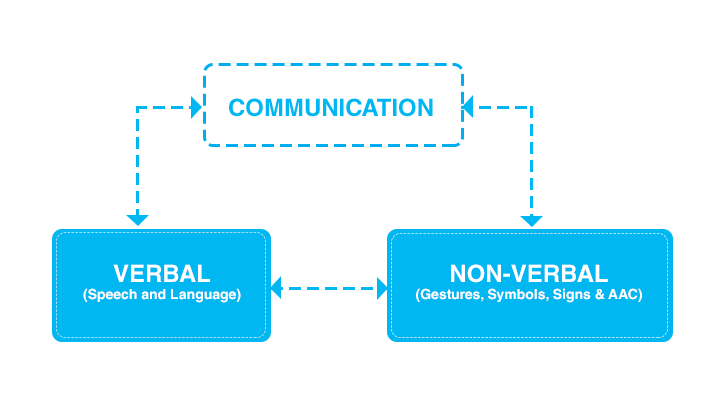Effective communication is essential for expressing needs, desires, and emotions in everyday life. It allows us to share our thoughts, ideas, feelings, and knowledge—and to understand those of the people who matter most. Communication can be broadly divided into two main types: verbal and non-verbal communication. Mastering both forms plays a critical role in building strong relationships, fostering understanding, and enhancing personal and professional interactions.

involves use of speech (sounds) and language (words/sentences) to understand or express our needs, thoughts, ideas and knowledge.
involves use of means other than verbal mode to understand or express our needs, feelings, thoughts, ideas and knowledge. It may include any of the following body language, variations in tone and pitch of voice, eye contact, gestures, symbols, sign language and Augmentative Alternative communication (AAC) devices.
Understanding Speech Disorders and the Role of Speech-Language Pathologists (SLPs)
Normal speech production relies on the coordinated function of the respiratory, laryngeal, articulatory, and resonatory systems. When this coordination is disrupted, various speech disorders can occur. These disorders typically fall into three main categories:
1. Articulation and Phonological Disorders
Children commonly make speech sound errors during early development, such as saying “lelo” instead of “yellow” or “wat” for “rat.” While this is part of typical speech development, persistent errors beyond the expected age may indicate a disorder. In such cases, it is important to consult a Speech-Language Pathologist (SLP) for evaluation and support.
2. Fluency Disorders
Fluency disorders disrupt the natural flow and rhythm of speech. When these disruptions—such as stuttering or prolonged pauses—interfere with effective communication, they may require professional attention. An SLP can determine whether the issue is part of normal disfluency or a diagnosable fluency disorder and recommend appropriate treatment.
3. Voice Disorders
Voice disorders result from issues with the vocal folds and the vocal tract’s resonatory function. These may affect voice quality, pitch, volume, or resonance. Conditions such as vocal nodules, paralysis, or misuse of the voice can contribute to these disorders. An experienced Speech-Language Pathologist can assess the problem and design a personalized voice therapy plan.
Expert Care from Trained Professionals
Speech-Language Pathologists are licensed experts trained to assess, diagnose, and treat communication disorders in both children (pediatric clients) and older adults (geriatric clients). Early intervention and personalized treatment plans are key to improving communication skills and quality of life.
Understanding Language Disorders and Their Management
Language is a complex and dynamic system of conventional symbols used for thinking and communication, according to the American Speech-Language-Hearing Association (ASHA). It is closely linked to cognitive development, meaning cognitive abilities directly impact all aspects of language use.
Language consists of five key components:
Semantics (meaning of words)
Syntax (sentence structure)
Morphology (word formation)
Pragmatics (social use of language)
Phonology (sound patterns)
Types of Language Disorders
1. Spoken Language Disorders
These disorders involve challenges in listening, comprehension, and/or verbal expression within one or more components of language. Most spoken language disorders are developmental and often identified in early childhood.
2. Written Language Disorders
Writing is the most complex form of language. Children with oral language difficulties are at a higher risk of developing reading and writing disorders, including dyslexia and written expression challenges.
3. Language Disorders Due to Neurological Impairment
This category includes conditions such as:
Aphasia
Dementia
Traumatic Brain Injury (TBI)
Right Hemisphere Damage
These disorders primarily affect adults and result from neurological damage impacting language comprehension and expression.
A Speech-Language Pathologist evaluates the type and severity of language disorders and designs personalized intervention plans. Treatment often involves collaboration with family members, caregivers, and other healthcare professionals to ensure a holistic approach. In most cases, the SLP is a core member of the rehabilitation or education team.
AAC is a system of communication that augments the communication in individuals with severe expressive communication difficulties. It includes use of signs/symbols, sign language, PECS and speech generating devices.
SLP evaluates the clients communicative needs, sensory and motor abilities, language and cognitive abilities before deciding on the most suitable AAC system for the client.
Peabody Picture Vocabulary Test, Fourth Edition (PPVT-4)
Vocabulary assessment plays a crucial role in evaluating the effects of injury or disease on language abilities. Moreover, vocabulary is strongly linked to reading comprehension and overall verbal intelligence.
The PPVT-4 is designed to measure receptive (hearing) vocabulary in both children and adults. Importantly, it is a norm-referenced, untimed, and individually administered tool, making it suitable for a wide range of individuals.
First, it provides insights into English language development, which is essential for diagnosing reading difficulties.
In addition, it is useful for screening preschool-aged children to identify early language concerns.
Furthermore, the PPVT-4 is especially valuable for assessing receptive language in children with autism, cerebral palsy, or other disabilities, since it does not require oral responses.
Time Required: 10–15 minutes
Age Range: 2 years 6 months to 90+ years
The EVT-2 serves as a quick and effective measure of expressive vocabulary knowledge and word retrieval skills. Unlike the PPVT-4, which assesses receptive skills, the EVT-2 focuses on what individuals can verbally produce.
To begin with, it serves as a screening tool for expressive language problems.
Additionally, it is beneficial for screening preschool children for early signs of delayed speech.
It also helps in measuring word retrieval abilities, which are key indicators of expressive language competence.
Moreover, the test provides useful data for understanding reading difficulties and underlying vocabulary gaps.
Finally, it supports the evaluation of how well an individual is acquiring English vocabulary, especially in bilingual or ESL contexts.
Time Required: 10–20 minutes
Age Range: 2 years 6 months to 90+ years
Contacts

6530 Al Qamra Ar Rahmaniyah
Riyadh, KSA
Copyright © 2026ABC Center. All Rights Reserved.